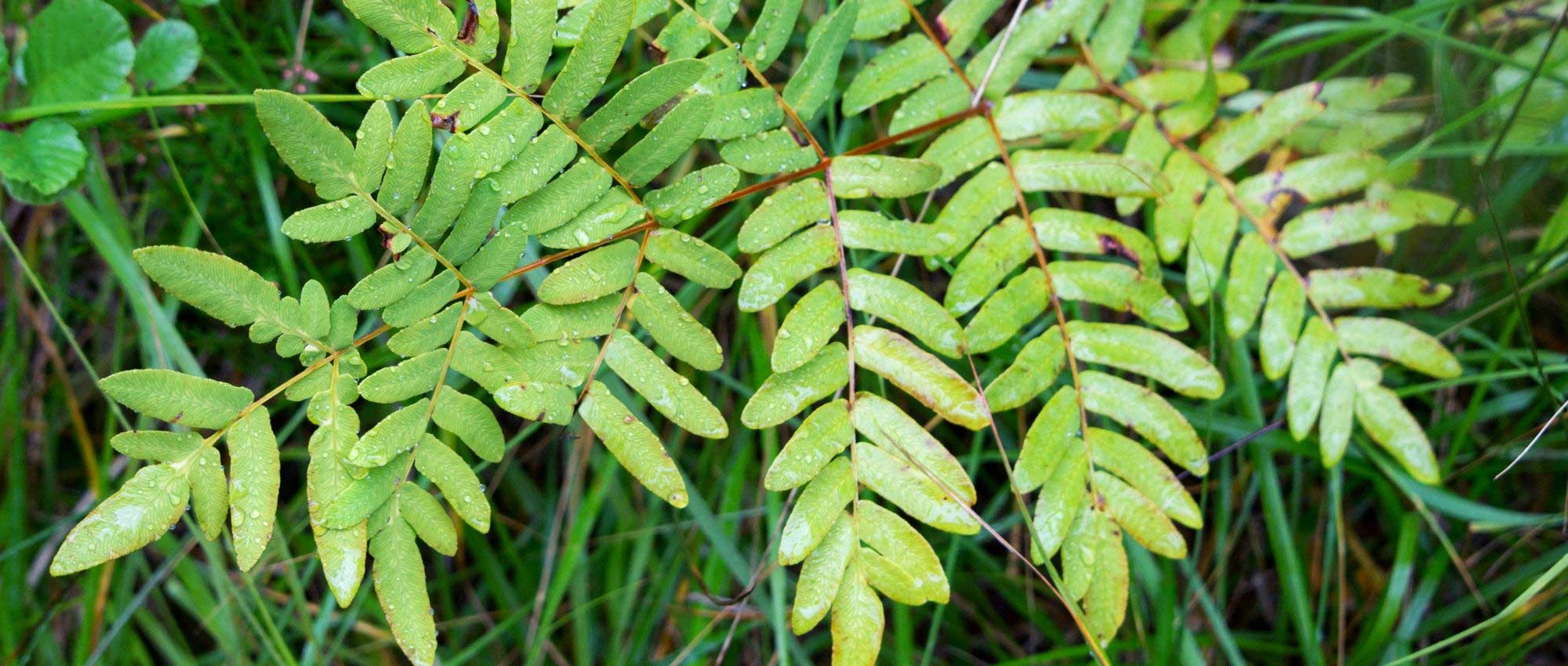
Osmunda, royal ferns: planting, growing, care
Contents
Osmonds in a nutshell
- Osmunda ferns are majestic and imposing, reaching up to 1.5 m in all directions
- They are hardy, long-lived, and not very susceptible to diseases and parasitic issues
- They require moist soil and are perfect for the edges of ponds
- These ferns are quite hardy, easily tolerating -15 °C and beyond
- We appreciate their elegantly divided foliage, which has a lovely soft green colour
A word from our Expert
Osmundas are among the largest hardy ferns that can be grown in the ground across most of France. These majestic ferns instantly create a striking effect in the garden. The most well-known is the Osmunda regalis, or Royal Osmunda, which can reach up to two metres in height. There are also other interesting species for the garden, such as the Osmunda cinnamonea, which has a more limited growth and bears beautiful decorative fertile fronds, or the Osmunda claytoniana. Depending on the varieties, osmundas measure between 50 cm and 2 m in height. The smaller ones, like the Osmunda japonica, are better suited for small spaces or city gardens.
While most ferns hide their spores on the underside of their fronds, this is not the case with osmundas! These bear very decorative fertile fronds in summer, which are brown in colour, earning the Royal Osmunda its nickname of “flowering fern.”
Osmundas are deciduous ferns: their fronds take on beautiful colours in autumn, often yellow or orange, before drying out. They will reappear in spring, first as curled croziers, then unfurling into large, majestic fronds of soft green.
Plant osmundas preferably in shade or partial shade, in cool or moist, fertile, rather acidic soil. They are indeed calcifuge plants: they do not appreciate limestone! The osmunda requires relatively little maintenance afterwards. It is mainly important to ensure that the soil does not dry out. This is a plant that takes a little time to establish, but it has great longevity thereafter.
Botany
Botanical data
- Latin name Osmunda sp.
- Family Osmundaceae
- Common name Osmunda, Royal fern
- Flowering none
- Height between 50 cm and 2 metres
- Exposure light shade, partial shade, non-burning sun
- Soil type moist, non-calcareous, rich in humus
- Hardiness -15 °C and above
Osmundas are perennial terrestrial ferns with deciduous foliage. There are about ten species of osmunda, which naturally grow in moist environments: they are generally found in marshes, swamps, and peat bogs… Osmundas are cosmopolitan, thus having a very wide global distribution. They can be found on nearly all continents, except Australia.
Osmundas have their own family, the Osmundaceae. This is a small family that includes only five botanical genera and about 16 species. Osmundas also belong to the broader group of Pteridophyta, which includes ferns, horsetails, and clubmosses. These primitive plants have the unique characteristic of reproducing by producing spores, rather than flowers and seeds.
The royal osmunda grows in moist, peaty, or marshy soils, or at the edges of watercourses. It often grows alongside Alder and sometimes with Willow. Although the royal osmunda is cosmopolitan, it is now endangered, as it is becoming increasingly rare in the wild, and is protected in many regions of France. This prohibits its collection in nature.
Osmundas are quite hardy ferns, capable of enduring temperatures below -15 °C. They grow relatively slowly but have a very long lifespan, as under good cultivation conditions they can live for over a century.
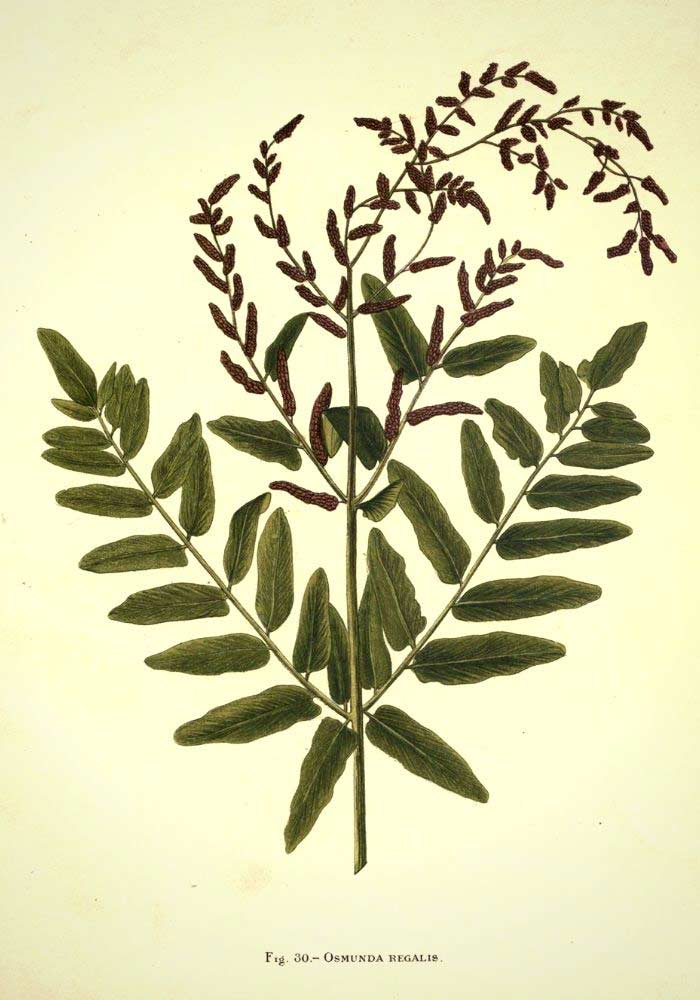
Osmunda regalis: botanical illustration
Osmundas form impressive clumps of leaves, which arise from a large upright, fibrous rhizome. This can rise a few centimetres above the soil level, resembling a small trunk or stipe. They form what is known as a tussock, a typical plant structure of wet and peaty areas, also formed by molinies and Carex paniculata. This rhizome, combined with the large size of the fronds, gives osmunda a resemblance to tree ferns.
The royal osmunda is a majestic fern that can reach up to 2 metres in height and 1.5 m in spread. There are also smaller osmunda species, such as the Osmunda japonica, which generally does not exceed 70 cm in height.
As with other ferns, the “leaves” of osmunda are called “fronds.” They produce two types of fronds: sterile fronds and fertile fronds. The latter bear the spores.
Fertile fronds appear in summer. They form large panicles of brown sporangia.
Osmundas produce fluffy croziers in spring, which then unfold to form elegant sterile fronds. The young fronds often take on beautiful colours. They are pink in Osmunda regalis, and a lovely purplish-red in the variety Osmunda regalis ‘Purpurascens’.
Fronds measure between 50 cm and 1.5 m in length, and can reach up to two metres in the largest osmunda species, such as Osmunda regalis. The fronds are beautifully dissected.
The fronds of osmunda are a lovely light green hue. They are twice divided (bipinnate): each frond bears at least six pairs of pinnae, which are further divided into eight pairs of pinnules or more. In the royal osmunda, the pinnules are large and widely spaced, giving a very airy and characteristic effect. In other species, such as Osmunda cinnamomea, the pinnules are much smaller and closer together, making the fronds resemble those of more common ferns, like Dryopteris. There are also varieties of osmunda with cristate leaves (the tips of the pinnules divide into several segments), such as Osmunda regalis ‘Cristata’.

Croziers and frond of the Royal Osmunda: the pinnules are large and relatively spaced (photos: Aurora Puentes / Vincent P. Lucas), young frond of Osmunda cinnamomea: the pinnules are much closer together (photo David J. Stang)
Osmundas produce fertile fronds in summer, bearing the sporangia. In the Osmunda cinnamomea, the fertile fronds bear only sporangia, while in other species, only part of the frond bears sporangia, while the rest of the frond has green leaflets, similar to the sterile fronds. In the royal osmunda, the sporangia are located at the top of the frond (the middle and bottom of it bearing green pinnules), while in Osmunda claytoniana, the sporangia are situated in the middle, earning it the English nickname interrupted fern, as the fronds appear interrupted in the centre.
Sterile fronds often have an upright and rigid appearance. They form upright panicles covered with sporangia. These initially have a green hue (before and at the time of their maturity), then turn rusty brown (once the spores have been released), before turning black.
In Osmunda cinnamomea, the fertile fronds bear only sporangia (no sterile pinnae), and take on a beautiful brown-cinnamon colour and have a well-erect, rigid habit, which earns it the name Cinnamon Osmunda.
When mature, the sporangia open into two valves, releasing the spores, which are then dispersed by the wind. They will germinate on the ground in the presence of moisture, giving rise to tiny organisms called prothalli. These prothalli produce gametes, and in the presence of water, will allow fertilization and the emergence of new osmunda.
In osmunda, unlike most ferns, the development of spores and sporangia is quite visible. The upright fertile fronds resemble a large inflorescence. This has earned the royal osmunda its nickname of “flowering fern.”
The foliage of osmunda is deciduous: it disappears in winter. The sterile fronds take on beautiful autumn colours before disappearing.
The fronds of the Royal Osmunda take on very beautiful orange-golden colours in autumn. Their vibrant hues range from yellow to orange and red.
Regarding the uses of osmunda, its roots are medicinal: they have diuretic, tonic, and astringent properties. The fibrous rhizome of the royal osmunda is also used to create potting mixes for orchids.

The narrow fertile fronds of Osmunda cinnamomea, bearing sporangia along their length (photo James Emery), fertile fronds and detail of the sporangia of Osmunda regalis: the fertile part is only at the top of the frond, the lower part bearing ordinary pinnules (photos Doug McGrady)
Read also
Ferns: growing and plantingThe main varieties of osmunda
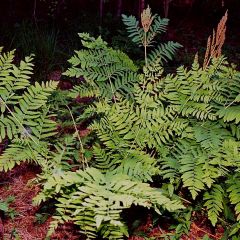
Osmunda regalis - Royal Fern
- Height at maturity 2 m
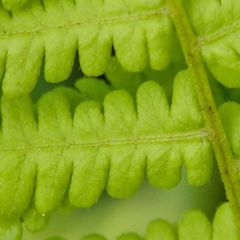
Osmunda cinnamonea - Cinnamon Fern
- Height at maturity 1 m
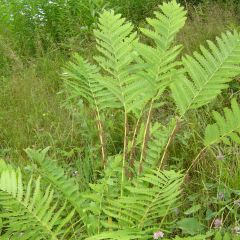
Osmunda claytoniana - Fern
- Height at maturity 90 cm
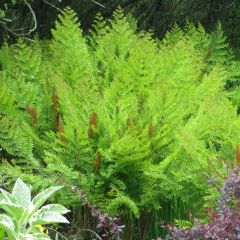
Osmunda regalis Purpurascens - Royal Fern
- Height at maturity 2 m
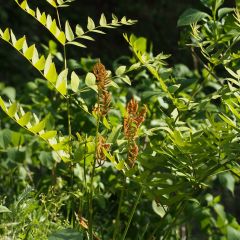
Osmunda japonica - Japanese Royal Fern
- Height at maturity 80 cm
Discover other Osmunda
View all →Available in 2 sizes
Available in 1 sizes
Available in 2 sizes
Available in 2 sizes
Available in 1 sizes
Available in 1 sizes
Planting
Where to plant?
You can plant the royal fern in shade, partial shade, or in non-burning sunlight. Avoid overly shaded or overly sunny situations. The ideal location would be in a light woodland, or under deciduous trees. If you plant it in sunlight, ensure that the soil remains moist. When in shade, the ferns grow larger and produce fewer fertile fronds. Conversely, when in sunlight, there are more fertile fronds, but the plant also takes on a more compact habit.
While ferns generally prefer cool soils, royal ferns truly need soil that remains moist or cool. They are ideal at the edge of a pond or stream. They thrive in humus-bearing soils. Don’t hesitate to add well-decomposed compost to enrich the soil. Royal ferns are calcifuge plants, which do not appreciate limestone. Plant them in acidic soil instead.
Royal ferns need time to establish. They grow slowly, especially in the first few years. It is therefore best to choose their location carefully to avoid having to move them later.
If you are cultivating the royal fern, allow enough space around it, as it can reach up to 1.5 m in spread. Additionally, you will enhance its appearance by leaving space around it. However, if you are short on space or have an urban garden, consider Osmunda japonica. Its smaller dimensions will be more suitable for this situation.
When to plant?
Plant the royal fern in spring, around April, or in autumn (September-October). Avoid periods of frost or extreme heat, which may hinder the plant’s successful establishment.
How to plant?
- Place the root ball in a basin filled with water to thoroughly rehydrate it.
- Dig a large planting hole, two to three times the size of the root ball.
- We recommend adding well-decomposed compost, which you will mix with the planting soil, and possibly a bit of heather soil.
- Remove your fern from its pot and plant it.
- Replace the substrate all around, then firm it down with the flat of your hand.
- Water generously.
- You can apply organic mulch around the clump to help maintain cool soil.
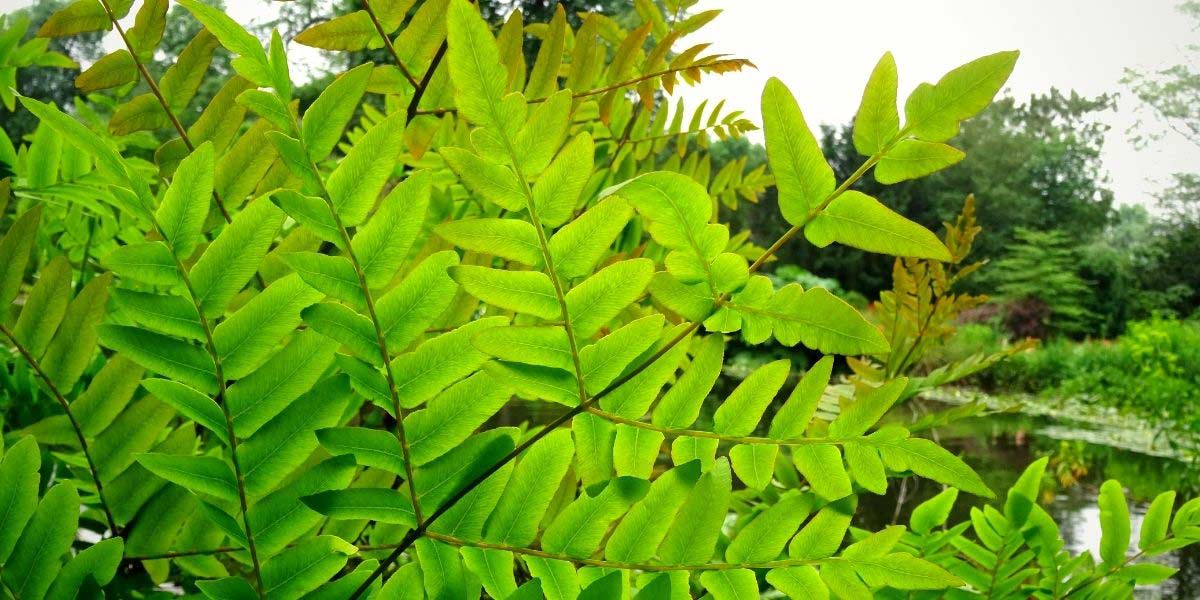
Osmunda regalis (photo Olive Titus)
Read also
Ferns: how to choose them?Care
Once established, osmunda requires little maintenance. We especially advise you to ensure that the soil remains cool, even moist. Don’t hesitate to water if necessary. This precaution is even more important if you have planted the osmunda in full sun, as it will not tolerate dry soil.
We recommend applying a layer of mulch around osmundas. This will help keep the soil cool for longer while limiting the growth of weeds. Choose an organic mulch: dead leaves, Ramial Chipped Wood (RCW), hemp mulch…
In summer, feel free to collect the spores when they are ripe, in an attempt to sow them. However, be aware that they do not keep for long, as their germination ability decreases rapidly.
As osmunda is deciduous, you can cut back the dry fronds in autumn to tidy up the clumps. It will produce new ones in spring.
Like most ferns, osmunda is not susceptible to diseases and pests.
Propagation
You can propagate osmundas by sowing spores or by dividing clumps. The latter technique is simpler and quicker.
Sowing
You can collect the spores in summer when they are ripe. Don’t wait too long to sow them, as they do not keep well. They will germinate more easily if you sow them within a few days of harvesting.
- Prepare a seed tray or container with sifted and moistened potting soil. We recommend microwaving it for 10 minutes to sterilise it: this will prevent the development of mosses or fungi.
- Lightly firm the substrate.
- Gently scatter the spores on the surface, but do not cover them!
- Cover the container with a transparent lid to create a humid and sterile atmosphere.
- Place your sowing in a bright location, out of direct sunlight, ideally at a temperature between 15 and 19 °C.
Osmunda spores germinate quite quickly compared to other ferns.
Discover our tips for successful spore sowing.
Dividing clumps
You can divide well-established osmundas that have been in place for several years. We recommend doing this in early spring, or possibly in autumn, around October.
- Identify an osmunda that has formed new shoots from its rhizome next to the main clump.
- Carefully take a section of the stump, using a spade if necessary. It should have roots attached.
- Replant it immediately in a new location after preparing the ground.
- Water generously.
Pairing ideas
Osmunda is ideal for undergrowth, in a naturalistic garden with a wild style. Pair it with other plants that enjoy cool shade, such as Solomon’s Seal, hellebore, Rodgersia, sweet woodruff, or wild garlic. Don’t hesitate to plant other ferns alongside it, such as Dryopteris or Athyrium. For flowering, consider Anemone nemorosa, Dicentra spectabilis, Ligularia dentata, or foxgloves. Also discover the stunning Aegopodium podagraria ‘Variegata’, which offers delicately variegated, cut foliage. It will bring a lot of brightness! In partial shade, at the edge of the undergrowth, you can also plant the Himalayan Blue Poppy, Meconopsis betonicifolia.
As it enjoys moist soils, Osmunda will thrive at the edge of a pond. It will beautifully accompany other plants with generous foliage, such as Gunnera manicata. This will create a lovely contrast in shape, between the fine, deeply cut leaves of Osmunda and the massive, entire-lamina foliage of Gunnera. Bring brightness with the yellow flowers of Iris pseudacorus or marsh marigold (Caltha palustris), excellent bank plants. Also discover the delicate white flowering of Water Clover, Menyanthes trifoliata, and the charming little blue flowers of the Marsh Forget-me-not, Myosotis palustris. Also consider the graphic stems of rushes and horsetails. To enhance this wild and natural aspect, integrate other ferns, such as Matteuccia or Thelypteris palustris.
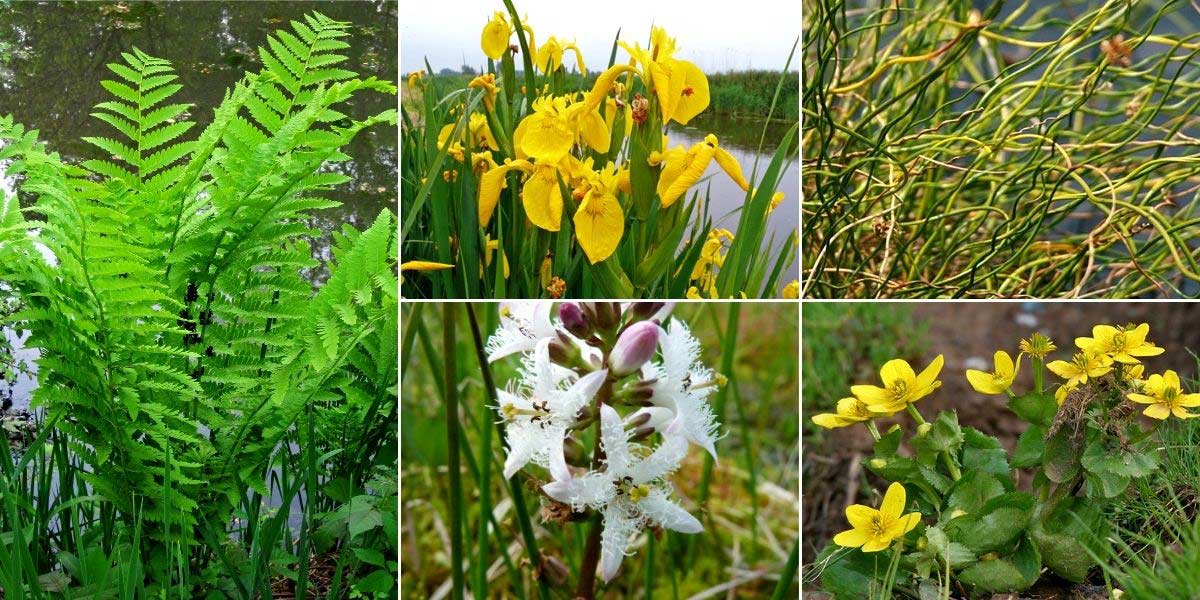
Feel free to install Osmunda at the edge of a pond, alongside other bank plants. Here, Osmunda claytoniana (photo James St. John), Iris pseudacorus (photo Jonathan Billinger), Juncus effusus ‘Spiralis’ (photo David J. Stang), Menyanthes trifoliata (photo Florian Grossir), and Caltha palustris (photo J.M.Garg)
Osmunda will also find its place in a Japanese-style, graphic, and modern garden. You can thus create a small space in a city garden, an inner courtyard, or a patio. Preferably choose Osmunda japonica for its incomparable graphic quality and relatively compact size. Define the beds with borders of Ophiopogon planiscapus ‘Nigrescens’, and install carpets of Helxine, which will uniformly cover the ground and create a very fresh atmosphere. To add some volume, integrate shrubs like Nandina domestica, or a Japanese maple. You can add some graphic ferns like Athyrium niponicum and Coniogramme emeiensis, as well as dwarf hostas (like the variety ‘Blue Mouse Ears’). Integrate some bamboos and horsetails, which you will plant in pots, to bring verticality and graphic quality. This will create a pleasant green corner in the city, where a fresh and modern atmosphere will prevail.
Useful resources
- Discover our range of osmunda
- To accompany osmunda in the garden, discover our entire range of ferns
- Our article: How to sow fern spores?
- The French website Fernatic, with plenty of information on ferns and their cultivation
- Subscribe!
- Contents
. Happy gardening! The Royal Fern: Planting, Cultivating, and Maintaining](https://en.promessedefleurs.eu/blogwp/wp-content/uploads/2020/07/osmonde-_-tout-savoir.jpg)



































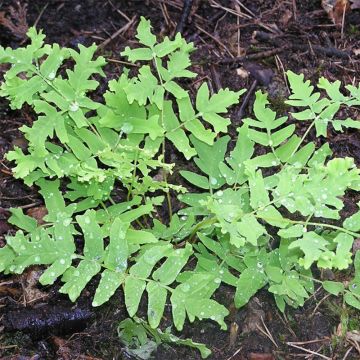

Comments